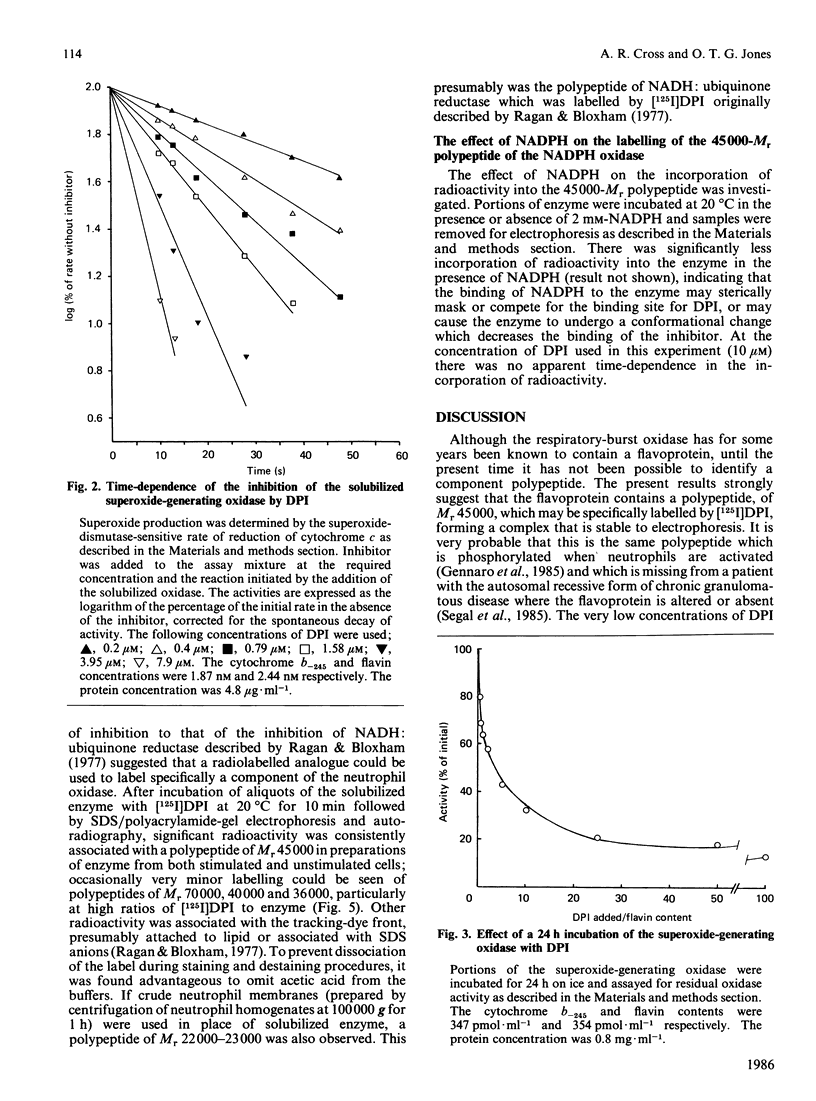Abstract
NADPH-dependent superoxide production by the solubilized oxidase of neutrophils was inhibited 36% by diphenylene iodonium at a 1:1 stoichiometry with the enzyme flavoprotein content. Addition of diphenylene iodonium strongly inhibited the NADPH-dependent reduction of both FAD and cytochrome b-245 in steady-state kinetic experiments. Incubation of solubilized enzyme with diphenylene [125I]iodonium resulted in the specific labelling of a polypeptide of Mr 45,000. In the presence of NADPH the amount of label incorporated into the polypeptide was reduced. There was no difference in labelling between enzyme prepared from stimulated or unstimulated cells.
Full text
PDF





Images in this article
Selected References
These references are in PubMed. This may not be the complete list of references from this article.
- Babior B. M. Oxidants from phagocytes: agents of defense and destruction. Blood. 1984 Nov;64(5):959–966. [PubMed] [Google Scholar]
- Babior B. M. Oxygen-dependent microbial killing by phagocytes (first of two parts). N Engl J Med. 1978 Mar 23;298(12):659–668. doi: 10.1056/NEJM197803232981205. [DOI] [PubMed] [Google Scholar]
- Bloxham D. P. The relationship of diphenyleneiodonium-induced hypoglycaemia to the specific covalent modification of NADH-ubiquinone oxidoreductase. Biochem Soc Trans. 1979 Feb;7(1):103–106. doi: 10.1042/bst0070103. [DOI] [PubMed] [Google Scholar]
- Cross A. R., Higson F. K., Jones O. T., Harper A. M., Segal A. W. The enzymic reduction and kinetics of oxidation of cytochrome b-245 of neutrophils. Biochem J. 1982 May 15;204(2):479–485. doi: 10.1042/bj2040479. [DOI] [PMC free article] [PubMed] [Google Scholar]
- Cross A. R., Jones O. T., Garcia R., Segal A. W. The association of FAD with the cytochrome b-245 of human neutrophils. Biochem J. 1982 Dec 15;208(3):759–763. doi: 10.1042/bj2080759. [DOI] [PMC free article] [PubMed] [Google Scholar]
- Cross A. R., Jones O. T., Harper A. M., Segal A. W. Oxidation-reduction properties of the cytochrome b found in the plasma-membrane fraction of human neutrophils. A possible oxidase in the respiratory burst. Biochem J. 1981 Feb 15;194(2):599–606. doi: 10.1042/bj1940599. [DOI] [PMC free article] [PubMed] [Google Scholar]
- Cross A. R., Parkinson J. F., Jones O. T. Mechanism of the superoxide-producing oxidase of neutrophils. O2 is necessary for the fast reduction of cytochrome b-245 by NADPH. Biochem J. 1985 Mar 15;226(3):881–884. doi: 10.1042/bj2260881. [DOI] [PMC free article] [PubMed] [Google Scholar]
- Cross A. R., Parkinson J. F., Jones O. T. The superoxide-generating oxidase of leucocytes. NADPH-dependent reduction of flavin and cytochrome b in solubilized preparations. Biochem J. 1984 Oct 15;223(2):337–344. doi: 10.1042/bj2230337. [DOI] [PMC free article] [PubMed] [Google Scholar]
- Dieppe P. A., Doherty M. The role of particles in the pathogenesis of joint disease. Curr Top Pathol. 1982;71:199–233. doi: 10.1007/978-3-642-68382-4_7. [DOI] [PubMed] [Google Scholar]
- Gabig T. G. The NADPH-dependent O-.2-generating oxidase from human neutrophils. J Biol Chem. 1983 May 25;258(10):6352–6356. [PubMed] [Google Scholar]
- Gatley S. J., Sherratt S. A. The effects of diphenyleneiodonium on mitochondrial reactions. Relation of binding of diphenylene[125I]iodonium to mitochondria to the extent of inhibition of oxygen uptake. Biochem J. 1976 Aug 15;158(2):307–315. doi: 10.1042/bj1580307. [DOI] [PMC free article] [PubMed] [Google Scholar]
- Gennaro R., Florio C., Romeo D. Activation of protein kinase C in neutrophil cytoplasts. Localization of protein substrates and possible relationship with stimulus-response coupling. FEBS Lett. 1985 Jan 28;180(2):185–190. doi: 10.1016/0014-5793(85)81068-1. [DOI] [PubMed] [Google Scholar]
- Hafeman D. G., Lucas Z. J. Polymorphonuclear leukocyte-mediated, antibody-dependent, cellular cytotoxicity against tumor cells: dependence on oxygen and the respiratory burst. J Immunol. 1979 Jul;123(1):55–62. [PubMed] [Google Scholar]
- Harper A. M., Dunne M. J., Segal A. W. Purification of cytochrome b-245 from human neutrophils. Biochem J. 1984 Apr 15;219(2):519–527. doi: 10.1042/bj2190519. [DOI] [PMC free article] [PubMed] [Google Scholar]
- Laemmli U. K. Cleavage of structural proteins during the assembly of the head of bacteriophage T4. Nature. 1970 Aug 15;227(5259):680–685. doi: 10.1038/227680a0. [DOI] [PubMed] [Google Scholar]
- Light D. R., Walsh C., O'Callaghan A. M., Goetzl E. J., Tauber A. I. Characteristics of the cofactor requirements for the superoxide-generating NADPH oxidase of human polymorphonuclear leukocytes. Biochemistry. 1981 Mar 17;20(6):1468–1476. doi: 10.1021/bi00509a010. [DOI] [PubMed] [Google Scholar]
- Lutter R., van Schaik M. L., van Zwieten R., Wever R., Roos D., Hamers M. N. Purification and partial characterization of the b-type cytochrome from human polymorphonuclear leukocytes. J Biol Chem. 1985 Feb 25;260(4):2237–2244. [PubMed] [Google Scholar]
- Pember S. O., Heyl B. L., Kinkade J. M., Jr, Lambeth J. D. Cytochrome b558 from (bovine) granulocytes. Partial purification from Triton X-114 extracts and properties of the isolated cytochrome. J Biol Chem. 1984 Aug 25;259(16):10590–10595. [PubMed] [Google Scholar]
- ROSSI F., ZATTI M. CHANGES IN THE METABOLIC PATTERN OF POLYMORPHO-NUCLEAR LEUCOCYTES DURING PHAGOCYTOSIS. Br J Exp Pathol. 1964 Oct;45:548–559. [PMC free article] [PubMed] [Google Scholar]
- Ragan C. I., Bloxham D. P. Specific labelling of a constituent polypeptide of bovine heart mitochondrial reduced nicotinamide-adenine dinucleotide-ubiquinone reductase by the inhibitor diphenyleneiodonium. Biochem J. 1977 Jun 1;163(3):605–615. doi: 10.1042/bj1630605. [DOI] [PMC free article] [PubMed] [Google Scholar]
- Segal A. W., Heyworth P. G., Cockcroft S., Barrowman M. M. Stimulated neutrophils from patients with autosomal recessive chronic granulomatous disease fail to phosphorylate a Mr-44,000 protein. Nature. 1985 Aug 8;316(6028):547–549. doi: 10.1038/316547a0. [DOI] [PubMed] [Google Scholar]



